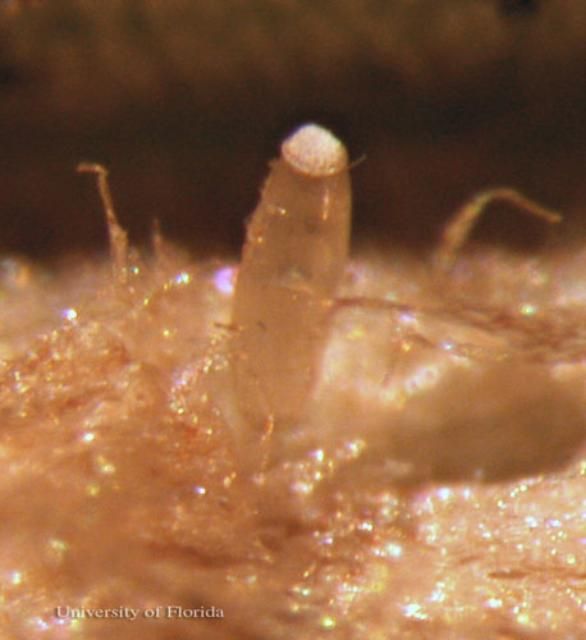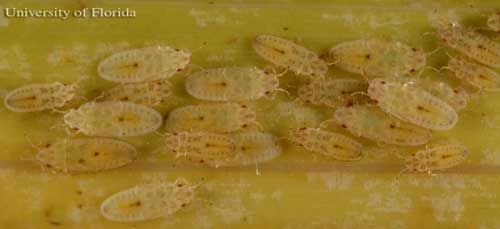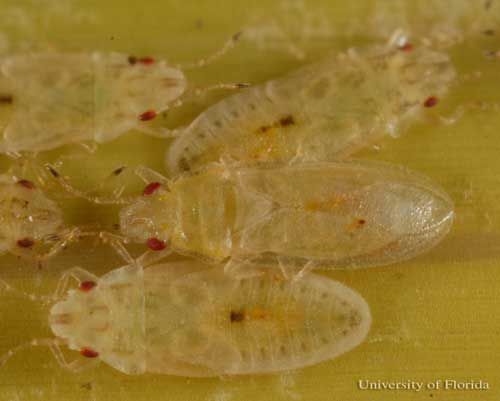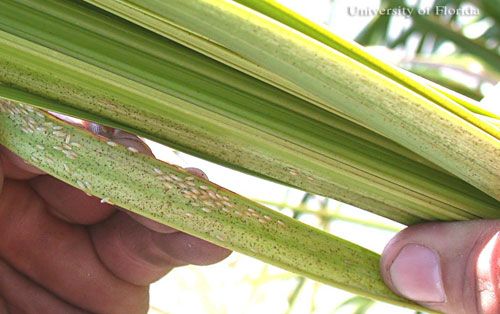The Featured Creatures collection provides in-depth profiles of insects, nematodes, arachnids and other organisms relevant to Florida. These profiles are intended for the use of interested laypersons with some knowledge of biology as well as academic audiences.
Introduction
The royal palm bug, Xylastodoris luteolus Barber, is one of the few arthropods that feed on Cuban royal palms, Roystonea regia, which are native to Florida and Cuba. This insect species is the only representative of the small, tropical family Thaumastocoridae in North America.
Distribution
The royal palm bug feeds only on Roystonea regia and the range of its host plant limits its distribution in Florida, Cuba, the Cayman Islands, and Yucatán, Mexico. However, reports of infestations are known only for Florida and Cuba (Howard 2001). In Florida, royal palm distribution is limited to the southern third of the peninsula.
Description
Egg
The egg is pale amber in color, elongate, 5 mm (~3/16 in) long, and capped at one end by a white operculum (Figure 1). Adult females usually lay a single egg in the tufts along the leaflet midvein. Females usually lay a maximum of 15 eggs, each of which hatches in about eight days.

Credit: Doug Caldwell, UF/IFAS
Nymph
There are five nymphal instars (Figures 2 and 3), each lasting several days. The time between egg to adult is 23 to 27 days (Howard 2001).

Credit: Lyle J. Buss, UF/IFAS

Credit: Lyle J. Buss, UF/IFAS
Adult
The royal palm bug is very small, with the adult reaching a length of only 2.5 mm (~1/8 in). Its general body shape is elongate-oval and somewhat flattened. Adults are pale yellow-green in color, except for the eyes, which are red (Figure 4). The immatures look similar to the adults but lack wings.

Credit: Lyle J. Buss, UF/IFAS
Life Cycle
Royal palm bug females deposit their eggs in the spring along the midribs of emerging leaflets. At the time of oviposition, leaflets are folded and the egg is placed inside of the fold. This helps protect the eggs. Females usually lay only one egg per day, which will hatch in eight or nine days. The time from the hatchling emerging to adult is about one month coinciding with the emergence of new leaves.
Damage
Royal palm bugs feed on freshly opened leaves causing scattered yellow spots (Figure 5) on the lower leaf surfaces. As feeding pressure increases (up to 300 bugs per leaflet have been observed), leaves develop brownish streaks and wilt. Damaged leaves eventually become gray and tattered (Figure 6). Royal palms produce a new leaf monthly. During the period of royal palm bug activity, about four leaves are damaged. Royal palm bugs rarely, if ever, kill palms, but their damage is unsightly and deleterious to the palm's health. Palms less than 3.7 m (12 ft 1 in) tall are seldom attacked.

Credit: Doug Caldwell, UF/IFAS

Credit: Doug Caldwell, UF/IFAS
Royal palm bugs, though present year-round, are generally considered to be minor pests. However, extensive damage due to royal palm bug feeding has been reported throughout southern Florida from time to time.
Management
Other than some general predation by miscellaneous arthropods, such as spiders, insecticidal control is the only known reliable method for controlling the royal palm bug in Florida. Chemical control with a contact insecticide can, however, be a challenge due to the height of infested palms and problems with insecticide drift. Root drenches with soil-applied neonicotinoid systemic insecticides are a viable management option because their application does not require special equipment to reach palm leaves. Soil application is preferred in urban landscapes over foliar treatments as this eliminates drift and avoids environmental concerns. To fully protect the aesthetic appearance of the palms, apply the soil drench at first symptoms of an infestation (Caldwell and Ali 2010).
Before drenching, scrape away mulch or grass near the base of the palm and pour the mixture very slowly around the base of the trunk in a band a few inches wide. If the soil is dry, wet it first with five gallons of water before applying the drench.
Selected References
Baranowski RM. 1958. "Notes on the biology of the royal palm bug, Xylastodoris luteolus Barber (Hemiptera: Thaumastocoridae)." Annals of the Entomological Society of America 51: 547–551.
Baranowski RM. 1966. The royal palm bug, Xylastodoris luteolus Barber (Hemiptera: Thaumastocoridae). Florida Department of Agriculture, Division of Plant Industry Entomology Circular 46.
Caldwell DL, Ali AD. 2010. "Control of royal palm bug (Xylastodoris luteolus) populations with soil applied neonicotinoid insecticides." Proceedings of the Florida State Horticultural Society 123: 304–307.
Howard FW. 2001. Thaumastocoridae, pp. 120-127. In Moore D (ed.), Insects on palms. CABI.
Howard FW, Stopek A. 1998. "Control of royal palm bug with imidicloprid." Principes 42: 80–84.